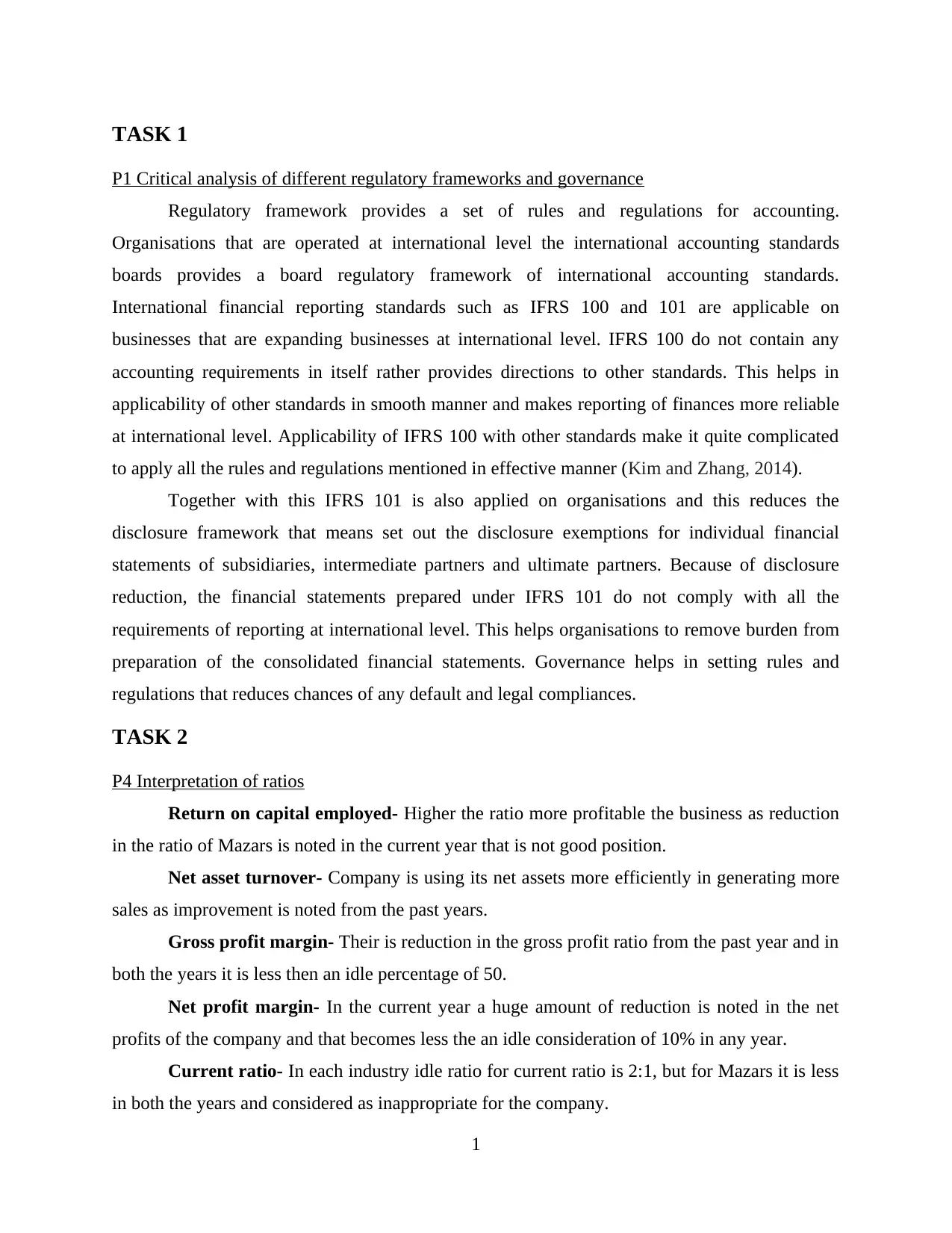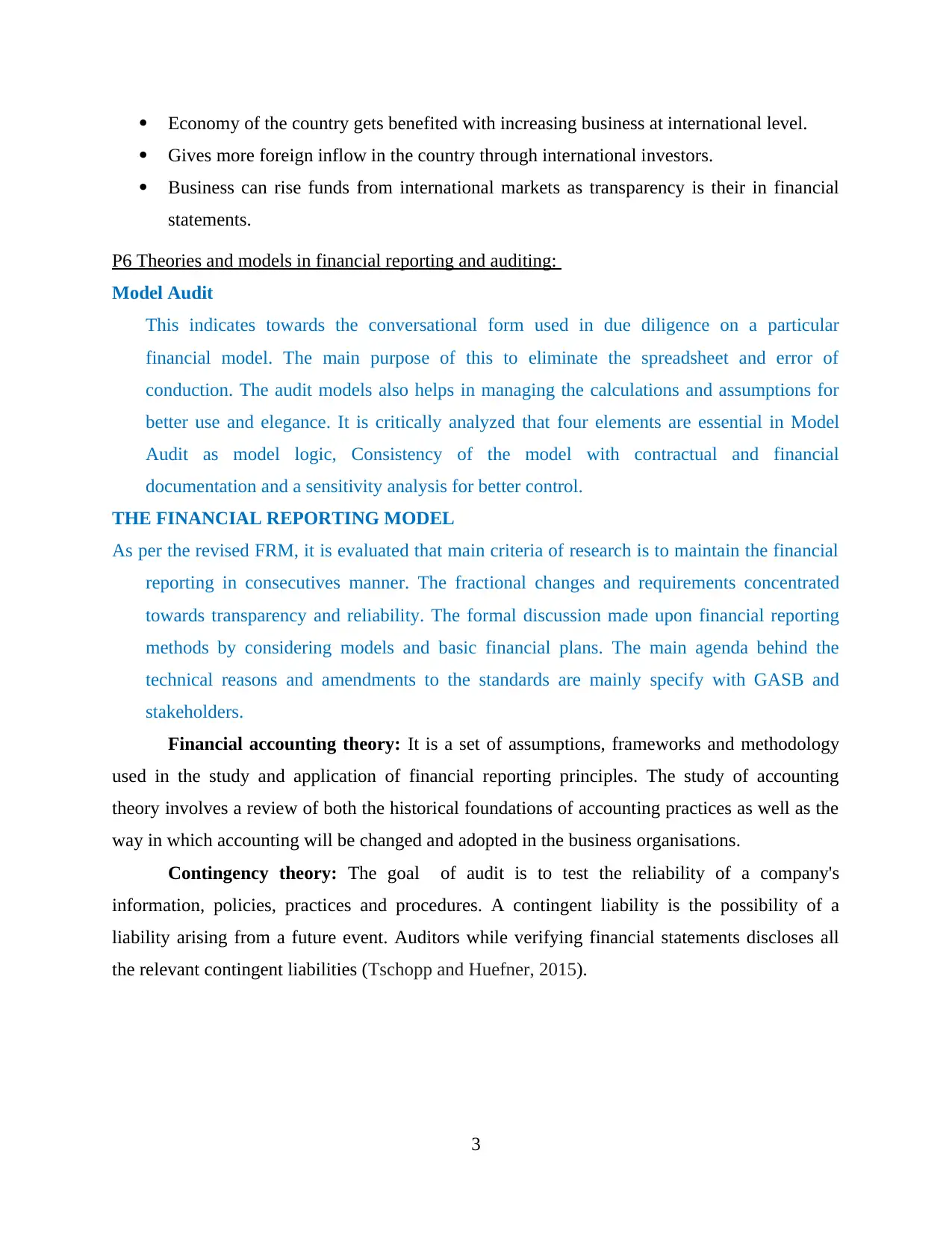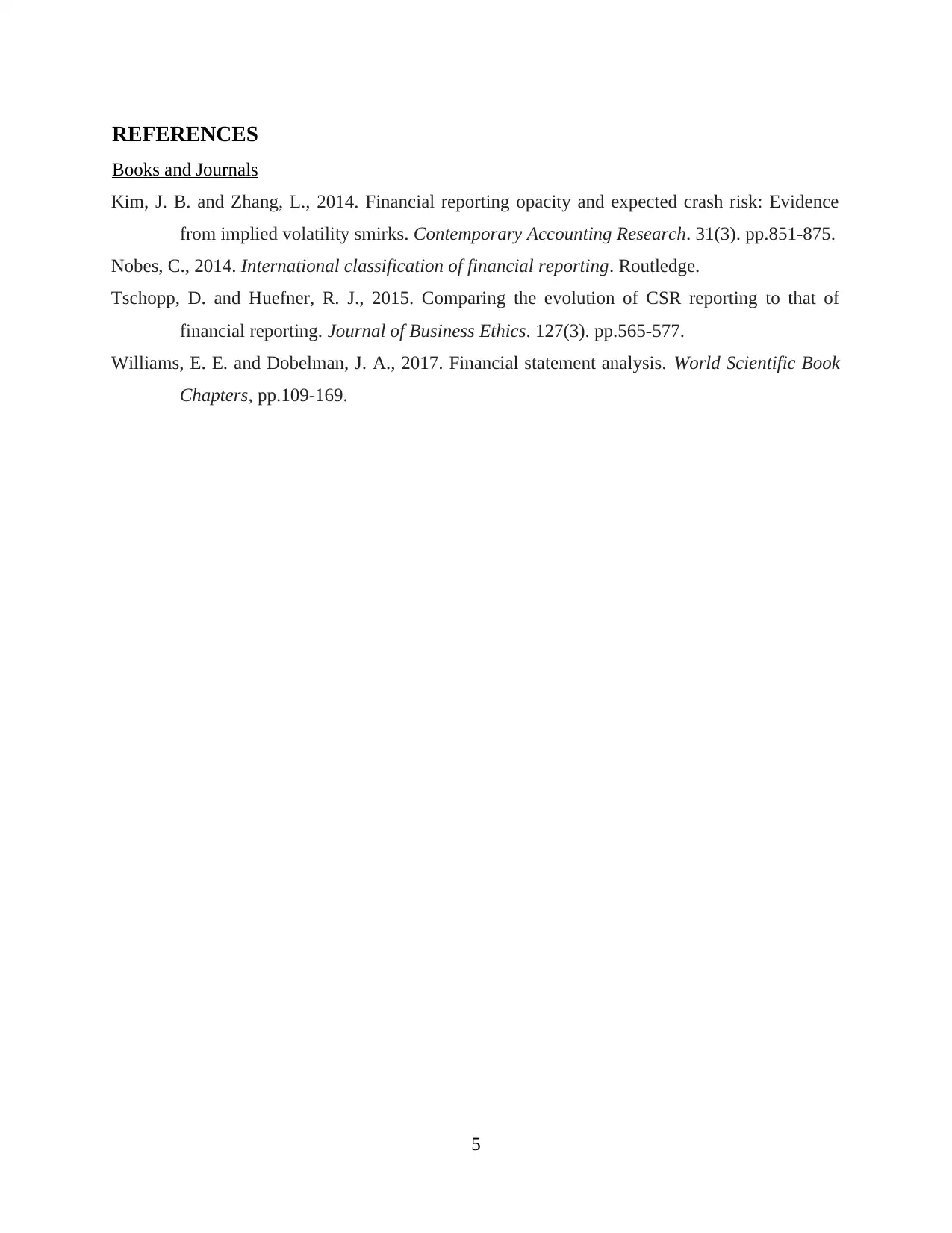Financial Reporting Analysis: Frameworks, Ratios, and Standards
VerifiedAdded on 2020/12/09
|8
|1461
|298
Report
AI Summary
This report provides a critical analysis of financial reporting, examining various regulatory frameworks and governance structures, particularly focusing on the International Financial Reporting Standards (IFRS) and their application. It includes an interpretation of key financial ratios, such as return on capital employed, net asset turnover, and profitability margins, assessing the financial performance of a sample company. The report also discusses the benefits of using International Accounting Standards (IAS) and IFRS, highlighting their role in improving investment, facilitating ethical compliance, and enabling international comparability. Furthermore, it explores financial reporting theories and models, including model audits and financial reporting models. The report concludes by comparing financial reporting practices across different countries, specifically contrasting U.S. GAAP and IFRS, emphasizing their impact on financial statement preparation and international business operations. References to relevant books and journals are also included.

FINANCIAL
REPORTING
REPORTING
Paraphrase This Document
Need a fresh take? Get an instant paraphrase of this document with our AI Paraphraser

Table of Contents
TASK 1............................................................................................................................................1
P1 Critical analysis of different regulatory frameworks and governance....................................1
TASK 2............................................................................................................................................1
P4 Interpretation of ratios............................................................................................................1
TASK 3............................................................................................................................................2
P5 Benefits of IAS and IFRS.......................................................................................................2
P6 Theories and models in financial reporting and auditing: .....................................................3
TASK 4............................................................................................................................................3
P7 Difference and importance of financial reporting across different countries.........................3
REFERENCES................................................................................................................................4
TASK 1............................................................................................................................................1
P1 Critical analysis of different regulatory frameworks and governance....................................1
TASK 2............................................................................................................................................1
P4 Interpretation of ratios............................................................................................................1
TASK 3............................................................................................................................................2
P5 Benefits of IAS and IFRS.......................................................................................................2
P6 Theories and models in financial reporting and auditing: .....................................................3
TASK 4............................................................................................................................................3
P7 Difference and importance of financial reporting across different countries.........................3
REFERENCES................................................................................................................................4

⊘ This is a preview!⊘
Do you want full access?
Subscribe today to unlock all pages.

Trusted by 1+ million students worldwide

TASK 1
P1 Critical analysis of different regulatory frameworks and governance
Regulatory framework provides a set of rules and regulations for accounting.
Organisations that are operated at international level the international accounting standards
boards provides a board regulatory framework of international accounting standards.
International financial reporting standards such as IFRS 100 and 101 are applicable on
businesses that are expanding businesses at international level. IFRS 100 do not contain any
accounting requirements in itself rather provides directions to other standards. This helps in
applicability of other standards in smooth manner and makes reporting of finances more reliable
at international level. Applicability of IFRS 100 with other standards make it quite complicated
to apply all the rules and regulations mentioned in effective manner (Kim and Zhang, 2014).
Together with this IFRS 101 is also applied on organisations and this reduces the
disclosure framework that means set out the disclosure exemptions for individual financial
statements of subsidiaries, intermediate partners and ultimate partners. Because of disclosure
reduction, the financial statements prepared under IFRS 101 do not comply with all the
requirements of reporting at international level. This helps organisations to remove burden from
preparation of the consolidated financial statements. Governance helps in setting rules and
regulations that reduces chances of any default and legal compliances.
TASK 2
P4 Interpretation of ratios
Return on capital employed- Higher the ratio more profitable the business as reduction
in the ratio of Mazars is noted in the current year that is not good position.
Net asset turnover- Company is using its net assets more efficiently in generating more
sales as improvement is noted from the past years.
Gross profit margin- Their is reduction in the gross profit ratio from the past year and in
both the years it is less then an idle percentage of 50.
Net profit margin- In the current year a huge amount of reduction is noted in the net
profits of the company and that becomes less the an idle consideration of 10% in any year.
Current ratio- In each industry idle ratio for current ratio is 2:1, but for Mazars it is less
in both the years and considered as inappropriate for the company.
1
P1 Critical analysis of different regulatory frameworks and governance
Regulatory framework provides a set of rules and regulations for accounting.
Organisations that are operated at international level the international accounting standards
boards provides a board regulatory framework of international accounting standards.
International financial reporting standards such as IFRS 100 and 101 are applicable on
businesses that are expanding businesses at international level. IFRS 100 do not contain any
accounting requirements in itself rather provides directions to other standards. This helps in
applicability of other standards in smooth manner and makes reporting of finances more reliable
at international level. Applicability of IFRS 100 with other standards make it quite complicated
to apply all the rules and regulations mentioned in effective manner (Kim and Zhang, 2014).
Together with this IFRS 101 is also applied on organisations and this reduces the
disclosure framework that means set out the disclosure exemptions for individual financial
statements of subsidiaries, intermediate partners and ultimate partners. Because of disclosure
reduction, the financial statements prepared under IFRS 101 do not comply with all the
requirements of reporting at international level. This helps organisations to remove burden from
preparation of the consolidated financial statements. Governance helps in setting rules and
regulations that reduces chances of any default and legal compliances.
TASK 2
P4 Interpretation of ratios
Return on capital employed- Higher the ratio more profitable the business as reduction
in the ratio of Mazars is noted in the current year that is not good position.
Net asset turnover- Company is using its net assets more efficiently in generating more
sales as improvement is noted from the past years.
Gross profit margin- Their is reduction in the gross profit ratio from the past year and in
both the years it is less then an idle percentage of 50.
Net profit margin- In the current year a huge amount of reduction is noted in the net
profits of the company and that becomes less the an idle consideration of 10% in any year.
Current ratio- In each industry idle ratio for current ratio is 2:1, but for Mazars it is less
in both the years and considered as inappropriate for the company.
1
Paraphrase This Document
Need a fresh take? Get an instant paraphrase of this document with our AI Paraphraser

Quick ratio- Realisation of assets to pay quick liability of Mazars is not sufficient to
meet all the liabilities. A reduction from past year is recorded and this is not a good situation.
Inventory holding period- company is holding its inventory for almost three month
which is very expensive and needs to reduce this period to become more profitable.
Trade receivables collection period- It has reduced from the past year and shows
efficiency of business to perform well.
Trade payable payment period- This has reduced from the past year which shows that
payments are made more often then past years.
Debt to equity- Amount of debt is reducing in comparison to shareholders equity which
reflects efficiency of the company.
Dividend yield- Percentage of distributing dividend to stock holders from past years has
reduce that is negative sign for image of the company (Nobes, 2014).
Dividend coverage ratio- Amount of net profits in the current year has reduced in
comparison to declared dividend that means reduction in the profitability in business.
TASK 3
P5 Benefits of IAS and IFRS
IAS is a set of accounting standards developed and supervised by the UK based
international accounting standards board. The purpose of these standards is to ensure that the
financial centres of the world can become more correct and accounting can be done in a manner
which is accepted at international level. Benefits of IAS are as follows-
Helps in improving investments at international level through creating more transparency
by following set standards.
Following set guideline by huge business organisations helps in facilitating ethical
compliances and more consumer believe is garbed in businesses which follows a set of
rules.
Following IAS in financial reporting set general standards which makes comparison easy
in two businesses for two years.
IFRS issued by International Accounting Standards Board to provide a common global
language for business affairs so that company accounts are understandable and comparable
across international boundaries. Benefits of IFRS are as follows-
2
meet all the liabilities. A reduction from past year is recorded and this is not a good situation.
Inventory holding period- company is holding its inventory for almost three month
which is very expensive and needs to reduce this period to become more profitable.
Trade receivables collection period- It has reduced from the past year and shows
efficiency of business to perform well.
Trade payable payment period- This has reduced from the past year which shows that
payments are made more often then past years.
Debt to equity- Amount of debt is reducing in comparison to shareholders equity which
reflects efficiency of the company.
Dividend yield- Percentage of distributing dividend to stock holders from past years has
reduce that is negative sign for image of the company (Nobes, 2014).
Dividend coverage ratio- Amount of net profits in the current year has reduced in
comparison to declared dividend that means reduction in the profitability in business.
TASK 3
P5 Benefits of IAS and IFRS
IAS is a set of accounting standards developed and supervised by the UK based
international accounting standards board. The purpose of these standards is to ensure that the
financial centres of the world can become more correct and accounting can be done in a manner
which is accepted at international level. Benefits of IAS are as follows-
Helps in improving investments at international level through creating more transparency
by following set standards.
Following set guideline by huge business organisations helps in facilitating ethical
compliances and more consumer believe is garbed in businesses which follows a set of
rules.
Following IAS in financial reporting set general standards which makes comparison easy
in two businesses for two years.
IFRS issued by International Accounting Standards Board to provide a common global
language for business affairs so that company accounts are understandable and comparable
across international boundaries. Benefits of IFRS are as follows-
2

Economy of the country gets benefited with increasing business at international level.
Gives more foreign inflow in the country through international investors.
Business can rise funds from international markets as transparency is their in financial
statements.
P6 Theories and models in financial reporting and auditing:
Model Audit
This indicates towards the conversational form used in due diligence on a particular
financial model. The main purpose of this to eliminate the spreadsheet and error of
conduction. The audit models also helps in managing the calculations and assumptions for
better use and elegance. It is critically analyzed that four elements are essential in Model
Audit as model logic, Consistency of the model with contractual and financial
documentation and a sensitivity analysis for better control.
THE FINANCIAL REPORTING MODEL
As per the revised FRM, it is evaluated that main criteria of research is to maintain the financial
reporting in consecutives manner. The fractional changes and requirements concentrated
towards transparency and reliability. The formal discussion made upon financial reporting
methods by considering models and basic financial plans. The main agenda behind the
technical reasons and amendments to the standards are mainly specify with GASB and
stakeholders.
Financial accounting theory: It is a set of assumptions, frameworks and methodology
used in the study and application of financial reporting principles. The study of accounting
theory involves a review of both the historical foundations of accounting practices as well as the
way in which accounting will be changed and adopted in the business organisations.
Contingency theory: The goal of audit is to test the reliability of a company's
information, policies, practices and procedures. A contingent liability is the possibility of a
liability arising from a future event. Auditors while verifying financial statements discloses all
the relevant contingent liabilities (Tschopp and Huefner, 2015).
3
Gives more foreign inflow in the country through international investors.
Business can rise funds from international markets as transparency is their in financial
statements.
P6 Theories and models in financial reporting and auditing:
Model Audit
This indicates towards the conversational form used in due diligence on a particular
financial model. The main purpose of this to eliminate the spreadsheet and error of
conduction. The audit models also helps in managing the calculations and assumptions for
better use and elegance. It is critically analyzed that four elements are essential in Model
Audit as model logic, Consistency of the model with contractual and financial
documentation and a sensitivity analysis for better control.
THE FINANCIAL REPORTING MODEL
As per the revised FRM, it is evaluated that main criteria of research is to maintain the financial
reporting in consecutives manner. The fractional changes and requirements concentrated
towards transparency and reliability. The formal discussion made upon financial reporting
methods by considering models and basic financial plans. The main agenda behind the
technical reasons and amendments to the standards are mainly specify with GASB and
stakeholders.
Financial accounting theory: It is a set of assumptions, frameworks and methodology
used in the study and application of financial reporting principles. The study of accounting
theory involves a review of both the historical foundations of accounting practices as well as the
way in which accounting will be changed and adopted in the business organisations.
Contingency theory: The goal of audit is to test the reliability of a company's
information, policies, practices and procedures. A contingent liability is the possibility of a
liability arising from a future event. Auditors while verifying financial statements discloses all
the relevant contingent liabilities (Tschopp and Huefner, 2015).
3
⊘ This is a preview!⊘
Do you want full access?
Subscribe today to unlock all pages.

Trusted by 1+ million students worldwide

TASK 4
P7 Difference and importance of financial reporting across different countries
Companies that operate in United States prepare financial statements in accordance with
U.S. Generally Accepted Accounting Principles. Rest of the companies in the world follow
International Financial Reporting Standards. The major difference in the above two is regarding
their approach. IFRS accounting regulations reflects a principles based approach where as,
GAAP is taken as rules based approach. Method of inventory valuation under GAAP is last in
first out and under IFRS this form of inventory valuation is not followed. In GAAP research and
development costs are generally expensed as incurred. However, under IFRS development costs
may be capitalised.
It is important to follow different accounting system in different country which helps in
fulfilling all the requirements of financial reporting in most effective manner that results in
positive business image (Williams and Dobelman, 2017). From the above evaluation, it is
analysed that at international level IFRS provides more comprehensive overview and scale for
financial reporting. It works as an aid for multinational organizations and companies to
compensate the fractional details and figures with in the organization. The fractional charges also
helps in conducting the details with in organization with proper results.
4
P7 Difference and importance of financial reporting across different countries
Companies that operate in United States prepare financial statements in accordance with
U.S. Generally Accepted Accounting Principles. Rest of the companies in the world follow
International Financial Reporting Standards. The major difference in the above two is regarding
their approach. IFRS accounting regulations reflects a principles based approach where as,
GAAP is taken as rules based approach. Method of inventory valuation under GAAP is last in
first out and under IFRS this form of inventory valuation is not followed. In GAAP research and
development costs are generally expensed as incurred. However, under IFRS development costs
may be capitalised.
It is important to follow different accounting system in different country which helps in
fulfilling all the requirements of financial reporting in most effective manner that results in
positive business image (Williams and Dobelman, 2017). From the above evaluation, it is
analysed that at international level IFRS provides more comprehensive overview and scale for
financial reporting. It works as an aid for multinational organizations and companies to
compensate the fractional details and figures with in the organization. The fractional charges also
helps in conducting the details with in organization with proper results.
4
Paraphrase This Document
Need a fresh take? Get an instant paraphrase of this document with our AI Paraphraser

REFERENCES
Books and Journals
Kim, J. B. and Zhang, L., 2014. Financial reporting opacity and expected crash risk: Evidence
from implied volatility smirks. Contemporary Accounting Research. 31(3). pp.851-875.
Nobes, C., 2014. International classification of financial reporting. Routledge.
Tschopp, D. and Huefner, R. J., 2015. Comparing the evolution of CSR reporting to that of
financial reporting. Journal of Business Ethics. 127(3). pp.565-577.
Williams, E. E. and Dobelman, J. A., 2017. Financial statement analysis. World Scientific Book
Chapters, pp.109-169.
5
Books and Journals
Kim, J. B. and Zhang, L., 2014. Financial reporting opacity and expected crash risk: Evidence
from implied volatility smirks. Contemporary Accounting Research. 31(3). pp.851-875.
Nobes, C., 2014. International classification of financial reporting. Routledge.
Tschopp, D. and Huefner, R. J., 2015. Comparing the evolution of CSR reporting to that of
financial reporting. Journal of Business Ethics. 127(3). pp.565-577.
Williams, E. E. and Dobelman, J. A., 2017. Financial statement analysis. World Scientific Book
Chapters, pp.109-169.
5
1 out of 8
Related Documents
Your All-in-One AI-Powered Toolkit for Academic Success.
+13062052269
info@desklib.com
Available 24*7 on WhatsApp / Email
![[object Object]](/_next/static/media/star-bottom.7253800d.svg)
Unlock your academic potential
Copyright © 2020–2025 A2Z Services. All Rights Reserved. Developed and managed by ZUCOL.





